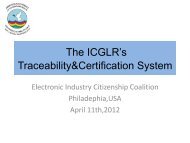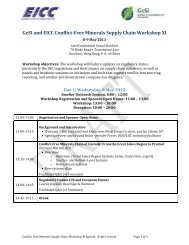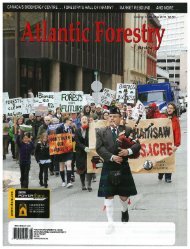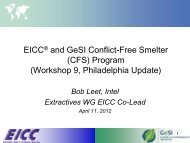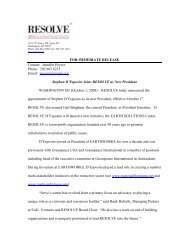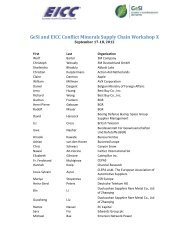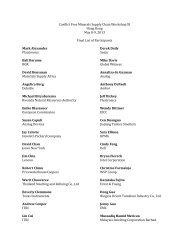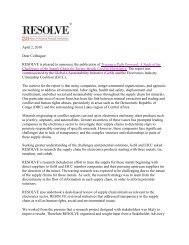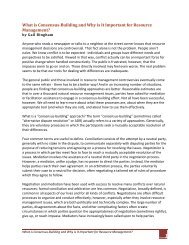Chapter 2: Actors – Business 41Box 2.3Internal Verification: Starbucks C.A.F.E. PracticesIn 2004, Seattle-based c<strong>of</strong>fee retailer Starbucks launched apilot certification project in Central America. <strong>The</strong> C<strong>of</strong>fee <strong>and</strong>Farm Equity (C.A.F.E.) Practices initiative has since exp<strong>and</strong>ed to140,000 farmers in about 20 countries. By 2010, participatingproducers provided Starbucks with 84 percent <strong>of</strong> its c<strong>of</strong>feebeans—just shy <strong>of</strong> 300 million pounds. In 2008, the companycommitted to buy 100 percent responsibly grown <strong>and</strong> ethicallytraded c<strong>of</strong>fee by 2015.Starbucks says that C.A.F.E. Practices is based on the principle<strong>of</strong> continuous improvement. Producers large <strong>and</strong> small (<strong>and</strong> 99percent <strong>of</strong> participating farms are 12 hectares or smaller) need topass a basic quality check. <strong>The</strong> applicants are then independentlycertified against a scorecard <strong>of</strong> environmental, social, <strong>and</strong>economic transparency criteria.According to Starbucks, the third-party certifiers involved inthis program operate entirely independently from the company.Starbucks works with California-based Scientific CertificationSystems to assess <strong>and</strong> train certifier organizations. C<strong>of</strong>feeproducers then contract one <strong>of</strong> these verifiers to undertake anexternal assessment <strong>of</strong> their operations.While full compliance by producers does not form an initialrequirement, Starbucks says it has a number <strong>of</strong> zero-tolerancecriteria. <strong>The</strong> list includes practices such as underage or forcedlabor <strong>and</strong> payment below the minimum wage.Starbucks <strong>of</strong>fers financial support in addition to a comprehensiveverification program, to help growers make the grade. <strong>The</strong>company funds a loan scheme for small farmers to the tune <strong>of</strong>$14.5 million a year. It aims to increase this to $20 million in thenear future. It also provides technical advice to farmers throughfarm support centers in Costa Rica <strong>and</strong> Rw<strong>and</strong>a (with otherssoon to follow in Colombia <strong>and</strong> China). Starbucks’ agronomists<strong>of</strong>fer training <strong>and</strong> advice in a range <strong>of</strong> environmentally friendly<strong>and</strong> efficient farming methods. One illustrative example is afreely distributed s<strong>of</strong>tware program that helps farmers betterinterpret soil <strong>and</strong> leaf analyses. This, in turn, helps reducereliance on chemical fertilizers <strong>and</strong> improve both crop yields <strong>and</strong>quality.<strong>The</strong> top performers in Starbucks’ rating system (those scoringmore than 80 percent on the C.A.F.E. Practices scorecard)receive a one-time, five-cents-per-pound premium for all thec<strong>of</strong>fee they sell to Starbucks. This is in addition to the extra thecompany was already paying its suppliers above market price. In2009, Starbucks paid a total <strong>of</strong> £2.5 million more than it would ifit paid suppliers strict market price.<strong>The</strong> Roles <strong>of</strong> Businessin St<strong>and</strong>ards <strong>and</strong>Certification SystemsBusinesses have been instrumental in the creation<strong>and</strong> proliferation <strong>of</strong> st<strong>and</strong>ards <strong>and</strong> certificationsystems. In many cases, companies have workedtogether with civil society groups, governmentagencies, <strong>and</strong> other stakeholders to create orinform st<strong>and</strong>ards <strong>and</strong> certification systems. <strong>The</strong>Marine Stewardship Council (MSC) <strong>and</strong> the ForestStewardship Council (FSC) systems, for instance,were created by—<strong>and</strong> continue to be overseenby—multi-stakeholder groups that include businessparticipation. Businesses have also developedtheir own st<strong>and</strong>ards <strong>and</strong> certification systems,<strong>of</strong>ten in partnership with nongovernmental organizations(NGOs), such as the C.A.F.E. Practicesst<strong>and</strong>ards developed by c<strong>of</strong>fee chain Starbucks<strong>and</strong> Conservation International (see Box 2.3) <strong>and</strong>multiple st<strong>and</strong>ards systems developed by themining industry (Schiavi, 2005). In these lattercases, businesses themselves serve as the systems’st<strong>and</strong>ard-setters, implementers, monitors,enforcers, <strong>and</strong> funders.Arguably businesses’ most important role, however,has been in promoting <strong>and</strong> driving the growth<strong>of</strong> certification systems. Companies have <strong>of</strong>tendone this by making public corporate responsibilitycommitments (typically in response to externalor internal pressures) <strong>and</strong> then using certificationas a means to deliver on those commitments.In recent years, large companies have becomeincreasingly bold in setting sustainability targetsacross a range <strong>of</strong> social <strong>and</strong> environmental areas intheir value chains (Park & Koehler, 2011). Notableexamples include: Mars’ commitment to obtainall <strong>of</strong> its cacao from sustainable sources by 2020;Unilever’s pledge to source all <strong>of</strong> its renewableraw materials sustainably by 2020; PepsiCo U.K.’scommitment to reduce carbon <strong>and</strong> water emissionsfrom key growers by 50 percent by 2015;<strong>and</strong> Walmart’s new sustainable agriculture policy,which includes, among other targets, a pledge towww.starbucks.com/responsibility/sourcing/c<strong>of</strong>fee<strong>Toward</strong> Sustainability: <strong>The</strong> Roles <strong>and</strong> Limitations <strong>of</strong> Certification
Chapter 2: Actors – Business 42Box 2.4Sustainable Agriculture Commitmentsby the World’s Largest RetailerIn October 2010, Walmart committed to buy a substantialpercentage <strong>of</strong> its agricultural products from certified sources.Its primary global <strong>and</strong> regional targets between now <strong>and</strong>2015 include:• Requiring sustainably sourced palm oil for all Walmart privatebr<strong>and</strong>products globally• Only sourcing beef that does not contribute to thedeforestation <strong>of</strong> the Amazon rainforest• In India, buying 50 percent <strong>of</strong> its fresh produce through thecompany’s Direct Farm Program• In China, upgrading 15 percent <strong>of</strong> Direct Farm products from“Green” to “Organic” certified• In Canada, purchasing 30 percent <strong>of</strong> the produce assortmentlocally• In the United States, doubling the sale <strong>of</strong> locally grown foodthrough its internal Heritage Agriculture programAccording to Walmart, these targets form part <strong>of</strong> a broadercommitment to promote sustainable agriculture that includes thefollowing procurement goals:• Selling $1 billion in food sourced from 1 million small <strong>and</strong>medium farmers• Providing training to 1 million farmers <strong>and</strong> farm workers onsuch topics as crop selection <strong>and</strong> sustainable farming practices• Increasing the income <strong>of</strong> the small <strong>and</strong> medium farmers itsources from by 10 to 15 percent in the United States• Investing more than $1 billion in its global fresh supply chain inthe next five yearsonly source beef that does not contribute to thedeforestation <strong>of</strong> the Amazon rainforest (see Box 2.4).Certification systems can provide companieswith a credible way to implement, evaluate, <strong>and</strong>communicate their progress against such commitments.In 2011, for example, Walmart <strong>and</strong>Sam’s Club updated their seafood sustainabilitypolicy to require that all <strong>of</strong> their wild-caught seafoodproducts be certified to MSC or equivalentsustainability st<strong>and</strong>ards. Similarly, U.S. grocerygiant Kroger has set a goal for 2015 <strong>of</strong> sourcingall <strong>of</strong> its top 20 wild-caught species from sourcesthat are either MSC-certified or involved in a “fisheryimprovement project” with the World WildlifeFund (WWF) (Marine Stewardship Council, 2011b).Unilever, with a supply chain consisting <strong>of</strong> morethan 200 different agricultural raw materials, optedto develop its own code <strong>of</strong> guiding principles forall crop types in all geographies. However, thecompany’s br<strong>and</strong>s benchmark this code againstexternal certification st<strong>and</strong>ards. Unilever commitsto buy from certified or noncertified suppliersthat can show compliance with its internal codethrough a self-assessment process. 3Sometimes, commitments by individual companieshave a ripple effect across their sector.U.S. retailer Timberl<strong>and</strong> developed an internalGreen Index in 2007 on the grounds that “widelyaccepted environmental st<strong>and</strong>ards do not exist.”This then led it to work with the Outdoor IndustryAssociation to develop an industry-wide index formeasuring the impact <strong>of</strong> outdoor products. 4 <strong>The</strong>apparel industry as a whole is now drawing onthis initiative, together with other leading internalst<strong>and</strong>ards such as Nike’s Considered Index, tocreate an industry-wide st<strong>and</strong>ard. This effort isbeing driven by the Sustainable Apparel Coalition, 5which, in turn, is informing the SustainabilityConsortium’s 6 work on a suite <strong>of</strong> consistent sustainabilityst<strong>and</strong>ards.• Reducing food waste in its emerging market stores <strong>and</strong> clubsby 15 percent3 www.unilever.com/aboutus/supplier/sustainablesourcing4 www.ecoindexbeta.org(Walmart, 2010a, 2010b)5 www.apparelcoalition.org6 www.sustainabilityconsortium.org<strong>Toward</strong> Sustainability: <strong>The</strong> Roles <strong>and</strong> Limitations <strong>of</strong> Certification



